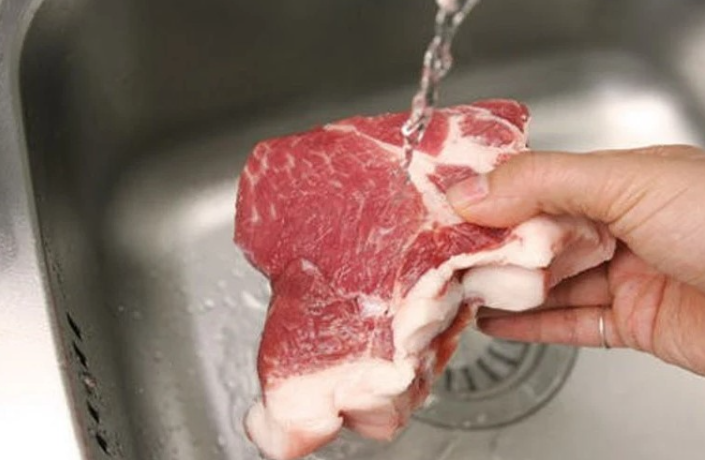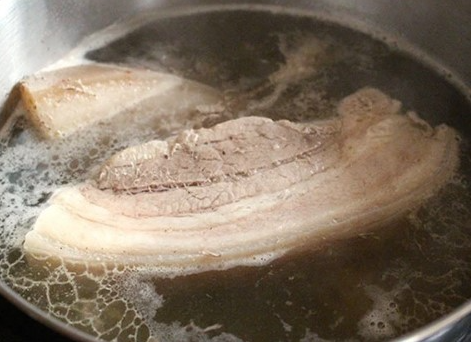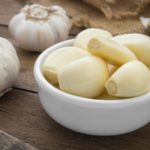Don’t Prepare the Meat Before Boiling

Many people have the habit of buying meat and immediately boiling it without any preparation. This can lead to uneven cooking, with the outside being soft while the inside remains raw.
To ensure even cooking, cut the meat into evenly sized, moderately thick pieces. Before boiling, scrape off any remaining hair from the skin, and rub the meat with lemon and coarse salt. Rinse thoroughly afterward. The lemon and salt effectively remove any unwanted odors, while the citric acid and vitamin C enhance the meat’s freshness and flavor.
For boiled meat dishes, it is best to choose pork belly (with alternating layers of fat and lean meat) or pork hock. If you prefer leaner cuts, opt for pork loin, but remember to soak it first in a dilute solution of salt and sugar, and then rinse it thoroughly before boiling. This process helps retain moisture in the meat, preventing it from drying out.

Poking and Flipping the Meat Repeatedly During Boiling
A common method to check if the meat is cooked is to poke it with a skewer, a technique passed down from generation to generation. However, it is important to resist the urge to constantly poke or flip the meat while boiling or frying it. Doing so will cause the juices and flavors to escape, resulting in drier and less tasty meat.
Adding Cold Water During Boiling
One mistake to avoid when boiling meat is adding cold water to a pot of boiling water. The sudden drop in temperature causes the protein and fat to coagulate immediately, making the meat tough and difficult to soften. The lean parts become harder, and the overall flavor is affected. Instead, always use hot water, ensuring it covers the meat entirely. If you need to add more water, use boiling water to maintain the temperature.
Overboiling the Meat

Some people tend to overboil meat to ensure it is thoroughly cooked, but this can lead to dry and mushy meat that loses its sweetness and becomes unappetizing. Overcooking meat can also impact its nutritional value. According to experts, at temperatures between 200 and 300 degrees Celsius, amino acids, creatinine, sugars, and harmless compounds in the meat can undergo chemical reactions, forming harmful substances.
Therefore, it is best to boil the meat just until it is cooked. This way, it retains its sweetness, fragrance, and crisp texture.
Cutting the Meat Immediately After Boiling

To ensure the meat stays hot, some people cut it immediately after boiling. However, this is a mistake as the meat is still soft and mushy at this point, making it difficult to cut into neat slices. Instead, place the boiled meat in a bowl of cold water for about a minute before removing and slicing it. This way, the meat remains warm, tasty, and aesthetically pleasing.
Tips for Delicious Boiled Meat
To prepare tasty boiled meat, start by choosing the right cut of meat. Pork belly is ideal, but pork hock, head, or shoulder can also be used, depending on your preference. Select a piece with a good balance of fat and lean meat to ensure attractive slices.
Add a pinch of salt to a pot of water, ensuring it is enough to submerge the meat. Place the cleaned meat in the pot and heat it over medium heat. Once the water starts to boil, remove the meat, discard the water, and rinse it again. Then, refill the pot with water, adding a little salt, vinegar, and crushed onion to eliminate any unwanted odors.
To ensure even cooking, avoid using oversized pieces of meat, as the inside may remain raw while the outside dries out. If you have a large or thick piece of meat, score it to facilitate even cooking. The boiling time will depend on the size of the meat, typically ranging from 15 to 25 minutes.
During the boiling process, remember to skim off any foam that forms on the surface to keep the broth clear and the meat looking fresh and attractive. After removing the cooked meat, immediately place it in a container of cold water (enough to submerge the meat). Once it has cooled completely, remove it, drain the excess water, and slice it.
Note: If you are boiling pork loin, be extra careful with the timing, as overboiling can make it dry and crumbly. For the best results, boil it just until it is cooked, and serve it warm. This way, it will be tender, sweet, and perfect for those watching their calorie intake.
Discover the Incredible Benefits of Soaking Garlic in Wine
Discover the benefits of garlic wine with GREEN ELECTRICAL! Garlic has many substances that are beneficial for your health, and soaking it in wine can help to strengthen your body's resistance to disease. Come with us as we explore how to soak garlic wine and how it can be used to improve your overall wellbeing.
How to Cut Down on Fuel Usage When Cooking
 Cooking‘>
Cooking‘>Families across the nation are striving to find ways to maximize their cost savings while still guaranteeing safety when utilizing a gas stove.



































